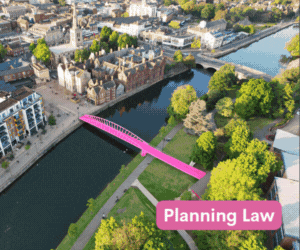Planning reform to accelerate housing delivery - at what cost?
Chrisa Tsompani examines how the Government’s sweeping planning reforms could reshape every layer of the building sector – from local authorities to small-medium builders, and considers the critical implications for environmental policies.
- Details
The last week of May 2025 marked a pivotal moment in the UK Government’s ongoing planning reform agenda, with the Department for Levelling Up, Housing and Communities (MHCLG) and the Department for Environment, Food and Rural Affairs (DEFRA) launching proposals to speed up housing delivery and modernise the planning system.
A more predictable and less restrictive planning system has been identified as key to unlocking faster housing delivery.
In May, MHCLG published the following papers:
- “Planning Reform Working Paper: Speeding Up Build Out” (25 May)
- “Technical consultation on implementing measures to improve Build Out transparency” (25 May)
- “Planning Reform Working Paper: Reforming Site Thresholds” (27 May) and
- “Reform of Planning Committees: Technical Consultation” (27 May)
On Thursday 28 May 2025, DEFRA also published two further consultations, namely:
- “Improving the implementation of Biodiversity Net Gain for minor, medium and brownfield development”; and
- “Consultation on Biodiversity Net Gain for Nationally Significant Infrastructure Projects (NSIPs)” [1]
These proposals - many of which build on earlier working papers and provisions within the Planning and Infrastructure Bill (PIB) - are clearly aligned with the Government’s ambition to deliver 1.5 million homes during this Parliament. They include balanced and innovative proposals, which were welcomed by the industry, however, some other proposals aiming at easing certain requirements under the Biodiversity Net Gain (BNG) regime have sparked controversy, revealing a clear divide in stakeholder opinions.
Speeding up Build Out and Transparency (responses by 7 July 2025)
Under the Build-Out proposals, some of which were introduced by the Levelling Up and Regeneration Act 2023 (LURA 2023), the Government is proposing to introduce:
- Provisions for a Build- Out Reporting Framework, under which the developers will submit a build-out statement to report to planning authorities the development’s commencement and progress.
- Powers for planning authorities to decline applications from individuals or entities with a poor record in delivering houses in the authority’s area.
- Provisions for 'Completion Notices’ served by authorities to developers if the former believe that the approved development won’t be delivered within a specified timeframe, with the possibility for planning permission to cease
- The option of Conditional Confirmation of Compulsory Purchase Orders (CPOs) for sites with alternative proposals, under which Landowners will be allowed to pursue their alternative proposals within defined timescales but if they fail to meet agreed timescales, the conditional CPO can become unconditional.
- A new 'Delayed Homes Penalty' issued by authorities to developers who fall significantly behind a pre-agreed build-out schedule and cannot provide a valid justification for the delay.
Reforming Site Thresholds (responses by 9 July 2025)
Currently, the Town and Country Planning (Development Management Procedure) (England) Order 2015 only defines by reference to size the “Major Development”, i.e. any development involving the provision of 10 or more houses than 0.5 hectares. “Minor Development”, by default, means anything below the Major Development’s threshold, i.e. fewer than 10 homes or sites up to 0.5 hectares.
Recognising that Major Developments typically face extensive planning and regulatory requirements - including more complex BNG criteria and planning agreements - the Government now introduces a new “Medium Development” category (10–49 homes or up to 1.0 hectare). Each category, Minor, Medium and Major, could now be subject to more tailored and proportionate to their size policy requirements, as follows:
- For Minor Developments, the proposals include:
- Simplified BNG requirements - apply more streamlined BNG obligations, with the possibility of full exemption from such requirements
- Delegated decision making - determination of applicable requirements to be made by officers under delegated powers
- Reduced administrative burden - implement lighter validation and consultation requirements.
It is noted that the exemption from affordable housing contributions except for Designated Rural Areas and the 8-week statutory determination, are proposed to remain.
There are also proposals for “Very Small Sites” (less than 0.1 ha), where it is proposed that even more streamlined processes apply, such as template design codes adaptable to local site size threshold and typologies or using digital tools to assist with site identification and compliance checks of design requirements on specific sites.
- For Medium Development, proposals include:
- Simplified BNG requirements - apply less complex BNG rules, including consideration of a simplified metric for medium-sized sites.
- Exemptions from additional burdens - exempt Medium Developments from the upcoming Buildings Safety Levy (effective Autumn 2026) and certain build-out transparency rules.
- Streamlined decision making - where appropriate, delegate determination of applications to officers, subject to proportionate consultation and validation requirements and minimal statutory information obligations.
- Determination timeline and monitoring - retain the 13-week determination period but introduce enhanced performance tracking to ensure efficiency.
Standardised s106 agreements’ templates for medium sites are also considered.
- For Major Development the framework remains largely unchanged. However, MHCLG is consulting on introducing a mixed tenure threshold, potentially applicable to schemes exceeding 500 units.
Reform of Planning Committees - Technical Consultation (closing 23 July 2025)
Most of these proposals were introduced in principle by PIB currently progressing through Parliament.
- National Scheme of Delegation
Currently each local authority determines their own scheme of delegations in accordance with the Local Authorities (Functions and Responsibilities) (England) Regulations 2000 (“the Functions Regulations 2000”) and their own constitutions. If the new national scheme of delegation becomes law, then each local authority will have to adopt it, resulting in uniformity and consistency across the country.
Under the new proposals the delegation will be determined under a tier system, under which all planning applications will fall into Tier A or Tier B. If a planning application falls into Tier A, the decision will be mandatorily delegated to officers. If an application falls into Tier B, it could be determined by a planning committee only if the Chief Planner and the Planning Committee Chair find it expedient to do so.
Tier A may include the following applications types:
- Householder developments
- Minor residential and commercial developments
- Reserved matters and non-material amendments (under s96A)
- BNG plan approvals
- Lawful Development or Certificates of Appropriate Alternative Development and
- Prior approvals (for permitted development rights)
Tier B may include applications:
- that don’t fall into Tier A, where significant local economic, social, or environmental impacts apply
- where the applicant is the local authority or a councillor or an officer
- under Section 73 of the Planning Act to vary conditions
- to review mineral planning conditions.
MHCLG is also seeking input on how to categorise:
- Special control applications (e.g. listed buildings, advertisement control and Tree Preservation Orders)
- Planning enforcement functions
- Section 106 agreements (aligned with the related application’s category)
- Size of committees
While the idea of mandatory strategic development committees has been dropped due to limited support, MHCLG is seeking a power in PIB for the Secretary of State to set out requirements on the size and composition of committees with maximum of 11 members. Smaller committees, where appropriate, guided by statutory advice, can also be allowed.
- Members’ training
The government is also committed to a mandatory training scheme for committee members. Currently, two certification models are being explored:
- A national certification scheme (MHCLG’s preferred option), involving an online test or
- A local certification approach, managed by individual planning authorities
Lastly, in a move to tighten accountability, the consultation proposes lowering the threshold for measuring local authorities’ performance. Currently, a local planning authority (LPA) may be flagged if over 10% of its decisions are overturned at appeal. The new proposal would reduce this to 5%, significantly raising the bar for performance.
For these amendments to become law, apart from other legislative interventions, certain provisions in the Functions Regulations 2000 will need to be changed and local authorities may need to review their constitutions and local governance rules.
Improving BNG for Minor, Medium, and Brownfield Development (closing on 24 July 2025)
This consultation mirrors some of the proposals of the sites’ thresholds papers and includes four broad areas of proposed reforms, which can be summarised as follows:#
1. Reforming existing and introducing new exemptions:
-
- Option 1 - Replace the self-build exemption with a broader single-dwelling exemption.
- Option 2 - Raise the ‘de minimis’ threshold for low-impact developments to allow more minor development to be exempt in practice.
- Option 3 - Allow full exemption from BNG for all minor developments.
- Option 4 - Exemptions for parks, public gardens and playing fields development.
- Option 5 - Exemptions for biodiversity-led projects and temporary planning permissions
2. Streamlining the Small Sites Metric (SSM) and considering whether to extend its application to medium developments.
3. Relaxation of the biodiversity gain hierarchy to treat off-site and on-site gains; disapplication of the Spatial Risk Multiplier (SRM) to reduce costs and improve access to off-site units.
4. Facilitating appropriate compensation for development on brownfield sites containing open mosaic habitats, applicable across all development types.
How could this effect BNG?
Since the introduction of the BNG regime, in February and April 2023, SMEs have expressed serious concerns about the barriers that were imposed to them because of the BNG requirements. Ecologists and environmental organisations have warned that any relaxation in the BNG requirements could potentially jeopardise the system altogether. Given that minor developments represent approximately three-thirds of planning decisions granted each year, removing BNG requirements from this category risks undermining the very purpose of the policy - ensuring that development contributes meaningfully to nature recovery.
Some commentators believe that BNG requirements can be addressed through strategic planning tools such as Local Nature Recovery Strategies, Spatial Development Strategies, updated Local Plans, Design Codes, and forthcoming National Development Management Policies, rendering the imposition of additional BNG requirements through other control systems unnecessary. These frameworks are expected to incorporate broader objectives centred on net zero, climate resilience, and biodiversity enhancement. However, these policies are still emerging and may take some time to be adopted nationwide.
Will the proposed reforms accelerate housing delivery?
It is evident that, under these proposals, the focus is on streamlining and simplifying the planning system.
The proposed national scheme of delegation is expected to increase predictability and consistency in decision-making across the country. Furthermore, the introduction of new site thresholds, along with the new category of Medium Developments, will shift a significant number of planning applications from the heavily regulated Major Developments to Minor and Medium Developments. This change will particularly benefit SMEs, whose projects typically fall within the Minor and Medium brackets, and who often operate with tighter margins and capital constraints, experiencing delayed planning decisions, added regulatory complexity, limited site availability, and restricted access to finance. It may also assist local authorities to increase their capacity and deal with certain applications faster and more efficiently.
Will this accelerate the delivery of more homes?
While streamlining the system should lead to more permissions for housing developments being granted, specific measures may not function as intended. For example, developers might strategically under develop sites to take advantage of the lower thresholds applied to Medium and Minor developments, potentially undermining the very goals of the proposals. It is also uncertain how the build-out reporting framework will work in practice and whether it will be used by local authorities consistently to have an impact on housing delivery.
The Government’s push to streamline the planning system and support SMEs is a welcome step, promising faster decisions on applications. While these efforts are commendable, the ambitious goal of delivering 1.5 million homes within this Parliament remains a steep challenge. In addition, the push to accelerate housing delivery by reducing regulatory hurdles may come at the expense of nature conservation efforts - an equally real risk that must also be addressed.
Chrisa Tsompani is a Partner at Davitt Jones Bould.
[1] Since this consultation is not directly related to housing delivery, it will not be examined further in this article.
Senior Lawyer - Contracts & Commercial
Trust Solicitor (Employment & Contract Law)
Contracts & Procurement Lawyer
Lawyer - Property
Locums
Poll









































